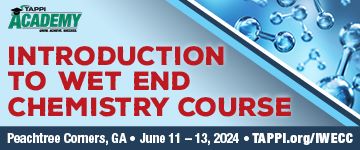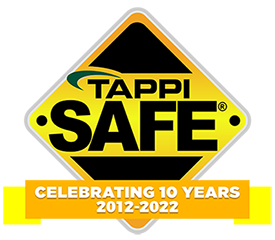 Search
Search
Use the search bar or filters below to find any TAPPI product or publication.
Filters
Content Type
Publications
Level of Knowledge
Collections
Magazine articles

Alberta newsprint and alberta research council bring deinking pilot plant on-stream, TAPPI JOURNAL, December 1992, Vol. 75(12)
Alberta newsprint and alberta research council bring deinking pilot plant on-stream, TAPPI JOURNAL, December 1992, Vol. 75(12)
Magazine articles

Mönsterås going 100% TCF as it increases production and minimizes emissions, December 1995 Tappi Journal [95Dec49.pdf]
Monsteras going 100% tcf as it increases production and minimizes emissions, TAPPI JOURNAL, December 1995, Vol. 78(12)
Journal articles

Magazine articles

Economic and competitive potential of lignin-based thermoplastics using a multicriteria decision-making method, TAPPI Journal September 2022
ABSTRACT: As a result of new lignin extraction plants hatching and increasing volumes of technical lignin becoming available, a variety of lignin derivatives, including phenolic resins and polyurethane (PU) foams, are reaching the marketplace or being used as intermediate products in many industrial applications. In the spectrum of possible lignin derivatives, thermoplastics appear particularly attractive due to a symbiosis of market, policy, and technology drivers. To assess the preferredness for lignin-based thermoplastics, this paper adapted a risk-oriented methodology formerly applied to assess lignin usage in various applications (phenol-formaldehyde [PF] resins, PU foams, and carbon fiber applications) to the case of lignin-based thermoplastics using hydroxypropylated lignin (HPL) and miscible blends of lignin and polyethylene oxide (PEO). The HPL is considered for garbage bags and agricultural films applications, while lignin-PEO blends are used as replacement for acrylonitrile butadiene styrene (ABS) in applications such as automotive parts. In the methodology, two phased-implementation strategies were defined for each thermoplastic derivative, considering perspectives for profit maximization (90 metric tons/day integrated units) and revenue growth (350 metric tons/day overall capacity), which were considered for implementation within a softwood kraft pulping mill. A set of six criteria representative of the main economic and market competitiveness issues were employed, and their respective importance weights were obtained in a multicriteria decision-making (MCDM) panel.Early-stage techno-economic estimates were done as a basis for the calculation of decision criteria. Compared to product derivatives previously assessed, capital investment for thermoplastic strategies appeared marginally higher due to the required lignin modification steps (on average 30% higher at similar capacity, and 6% for higher-scale revenue diversification strategies). Higher operating costs were also observed due to increased chemical expenses for all thermoplastic strategies, which are ultimately balanced by revenues associated with targeted thermoplastic products, leading to greater annual margins and cash flow generation over the project lifetime for thermoplastic strategies compared to other product applications (58% to 66% higher on average, at similar scale). Benefits of improved economics were reflected in economic criteria, internal rate of return (IRR), and cash flow on capital employed (CFCE), as well as in the price competitiveness criterion, CPC. Overall, the combination of relatively high lignin content in the plastic formulation and the less costly modification method contributed to lignin-PEO strategies, gaining the top two rankings. Based on their overall scores, both strategies defined for HPL would also integrate the group of “preferred” strategies, but are outranked by strategies that consider lignin positioning on PU foam applications.
Journal articles

Magazine articles

Eucalyptus black liquor properties in a lignin extraction process: density, dry solids, viscosity, inorganic, and organic content, TAPPI Journal March 2023
ABSTRACT: Extracting lignin from black liquor is becoming more common, although only a few research papers discuss the impact of the process on the liquor’s primary properties. This work aims to determine the changes in black liquor properties as it undergoes a lignin extraction process using carbon dioxide (CO2). A diluted eucalyptus black liquor sample (DBL) was acidified with CO2 to a final pH of 8.5. After filtration, the kraft lignin was removed, and the filtrated lignin lean black liquor (LLBL) was collected. Five acidified black liquors (ABL) samples were collected during acidification at pH 10.5; 10.0; 9.5; 9.0; and 8.5. The samples were analyzed regarding lignin content in solution, sodium carbonate (Na2CO3), sodium sulfate (Na2SO4), density, dry solids content, and viscosity. While Na2SO4 remained almost constant, Na2CO3 presented an enormous increase in its concentration when comparing DBL with LLBL. As pH decreased, the lignin content in the solution was also reduced due to lignin precipitation. The results showed similar behavior for dry solids, density, and viscosity of the supernatant, but an increase in density was observed around pH 9.00. In light of this, the density of LLBL turns out to be closer to the one in the initial DBL. The significant increase in carbonate content could explain this behavior during acidification with CO2 once the inorganic content significantly influences the property. The viscosity was determined from 10 s-1 to 2000 s-1. We observed a Newtonian behavior for all samples. The increase in carbonate content in the sample is crucial information to the recovery cycle, especially for calculating the mass and energy balance when targeting the use of the LLBL.
Journal articles

Magazine articles

Techno-economic analysis of hydrothermal carbonization of pulp mill biosludge, TAPPI Journal March 2023
ABSTRACT: For many mills, the biosludge from wastewater treatment is difficult to recycle or dispose of. This makes it a challenging side stream and an important issue for chemical pulping. It often ends up being burned in the recovery or biomass boiler, although the moisture and non-process element (NPE) contents make it a problematic fuel. Biosludge has proven resistant to attempts to reduce its moisture. When incinerated in the biomass boiler, the heat from dry matter combustion is often insufficient to yield positive net heat. Mixing the sludge with black liquor in the evaporator plant for incineration in the recovery boiler is more energy efficient, but is still an additional load on the evaporator plant, as well as introducing NPEs to the liquor. In this study, treating the biosludge by hydrother-mal carbonization (HTC), a mild thermochemical conversion technology, is investigated. The HTC process has some notable advantages for biosludge treatment; taking place in water, it is well suited for sludge, and the hydrochar product is much easier to dewater than untreated sludge. In this study, two HTC plant designs are simulated using IPSEpro process simulation software, followed by economic analysis. Low temperature levels are used to minimize investment costs and steam consumption. The results show that if the sludge is incinerated in a biomass boiler, payback periods could be short at likely electricity prices. The HTC treatment before mixing the sludge with black liquor in the evaporator plant is profitable only if the freed evaporator capacity can be used to increase the firing liquor dry solids content.
Journal articles

Magazine articles

Considerations in managing wastewater odor at pulp and paper operations, TAPPI Journal March 2022
ABSTRACT: Many pulp and paper mills are, at least periodically, faced with the release of odors that can migrate offsite and be considered a nuisance by nearby residents. At chemical pulp mills, perceptible odors associated with reduced sulfur compounds (RSCs) are common, many of which are highly perceptible owing to their low odor thresholds. As releases of RSCs and other odorous substances from production processes are progressively controlled, the proportional contribution from wastewater treatment systems to areal odors can increase. This review paper summarizes important fundamentals of odor generation, source identification, and control. Common odorous substances are identified, and mechanisms for their generation are summarized. Approaches for measuring odorous substances are detailed to enable more effective management, and various odor control strategies are discussed.
Magazine articles

A guide to developing a best management practices (bmp) plan for spent liquor, part II, TAPPI JOURNAL, December 1999, Vol. 82(12)
A guide to developing a best management practices (bmp) plan for spent liquor, part II, TAPPI JOURNAL, December 1999, Vol. 82(12)
Journal articles

Magazine articles

Editoral: Investing in the future: Writing and peer-reviewing for TAPPI Journal, TAPPI Journal July 2024
ABSTRACT: Those who actively participate in TAPPI realize how much there is to gain from the networking, educational resources, career development, and other opportunities that come with this involvement. One important opportunity is the ability to share your work and expertise with others in your field, and an excellent way to do this is by taking part in the TAPPI Journal peer-review process, either as an author or a reviewer or both.
Magazine articles

English as a first and second language - part 7: a strategy for spelling, TAPPI JOURNAL, October 1998, Vol.81(10)
English as a first and second language - part 7: a strategy for spelling, TAPPI JOURNAL, October 1998, Vol.81(10)
Magazine articles

The r & t system: everyone is responsible for innovation, TAPPI JOURNAL, September 2000, Vol. 83(9)
The r & t system: everyone is responsible for innovation, TAPPI JOURNAL, September 2000, Vol. 83(9)






